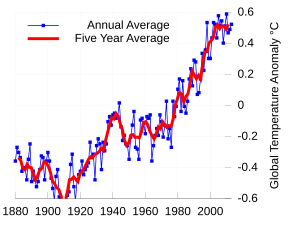February 23rd, 2012
Last week I had students from the grade 4-8 enrichment program participate in an exercise on climate change. Students and parents were asking if I thought this warm winter was a symptom of climate change. Good question!
Climate change is reflected in a rise in the Earth’s air and ocean temperatures that are averaged world-wide. In the last 100 years or so, average Earth temperatures have risen 0.6 degrees Celsius. Given our current pace of burning fossil fuels, the next 100 years may see a temperature increase of 2-5 degrees Celsius. That’s a lot, and would bring catastrophic consequences to many parts of the world. Some places will see even greater temperature increases, and some places may see temperatures drop due to changing wind patterns and ocean currents. The key is that average world-wide temperatures are rising.
Global warming is measured on a large scale, but most people evaluate climate change based on their local situation. If temperatures where you are seem unusually warm or you are experiencing a drought, you are more inclined to feel that climate change is affecting you. If things are relatively normal, or colder than usual where you are, you probably don’t worry too much about global warming. The key is to look for trends globally, and on a longer time frame.
Here are the warmest Januarys (Januaries?) over the last 75 years in Toronto:
1. 2006 2. 2002 3. 1990 4. 2008 5. 2012
That’s pretty good evidence of a pattern of warmer winters for us in southern Ontario. There are undoubtably places that have seen unseasonably cold winters over the last few years. What climate scientists see though, are world-wide patterns and trends that point to a warming planet.
Here is a study that predicts that London, Ontario will have an average temperature in 2080 that is 5.55 degrees Celsius warmer than in 1980.
http://www.ouranos.ca/Ontario/Results_html/Rapport.pdf
So, is this warm winter a sign of climate change? Given our current trends, and forecasts for the future, the likelihood that we experience a warmer winter increases each year. Today’s balmy weather is certainly within a normal range, it’s just that “normal” is changing too.
As an interesting side-note, when I teach that climate change may lead to starvation, floods, droughts and the spread of disease for many people on the planet, students and parents express a somewhat detached concern. When I tell them that we can expect fewer white Christmases, fewer outdoor rinks, and maybe no maple syrup in the future, they have a greater emotional reaction. Changes to environmentally-dependent aspects of our local culture seem to have a greater impact on Canadians than the fact that people are dying somewhere else.
